Reducing Unnecessary Urinary Catheter Use in the Emergency Department
Slide Presentation
Slide 1
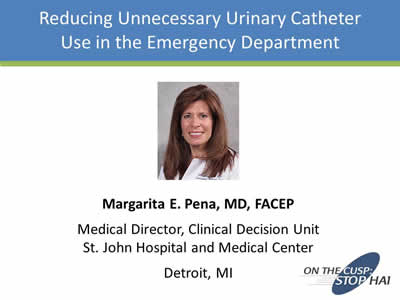
Reducing Unnecessary Urinary Catheter Use in the Emergency Department
Margarita E. Pena, MD, FACEP
Medical Director, Clinical Decision Unit
St. John Hospital and Medical Center
Detroit, MI
Image: Photo of Dr. Marguerite Pena.
Slide 2
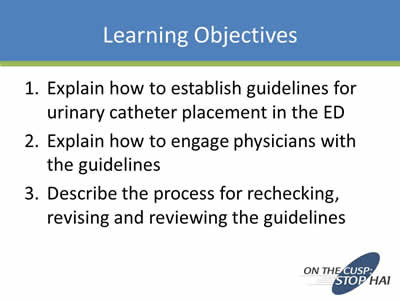
Learning Objectives
- Explain how to establish guidelines for urinary catheter placement in the ED
- Explain how to engage physicians with the guidelines
- Describe the process for rechecking, revising and reviewing the guidelines
Slide 3
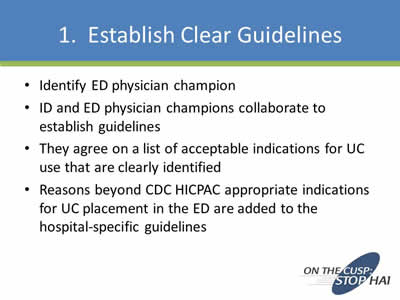
1. Establish Clear Guidelines
- Identify ED physician champion
- ID and ED physician champions collaborate to establish guidelines
- They agree on a list of acceptable indications for UC use that are clearly identified
- Reasons beyond CDC HICPAC appropriate indications for UC placement in the ED are added to the hospital-specific guidelines
Slide 4
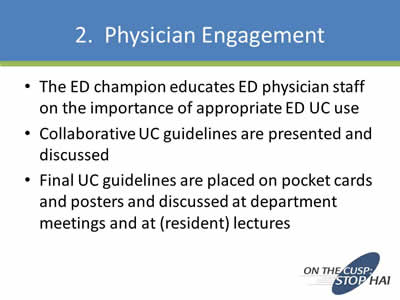
2. Physician Engagement
- The ED champion educates ED physician staff on the importance of appropriate ED UC use
- Collaborative UC guidelines are presented and discussed
- Final UC guidelines are placed on pocket cards and posters and discussed at department meetings and at (resident) lectures
Slide 5
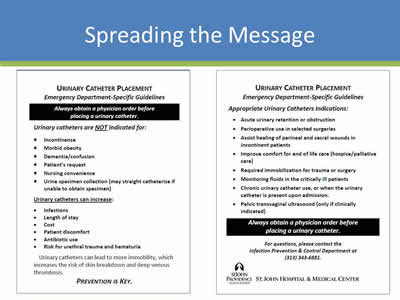
Spreading the Message
Image: Screen shot of the emergency department-specific guidelines.
Slide 6
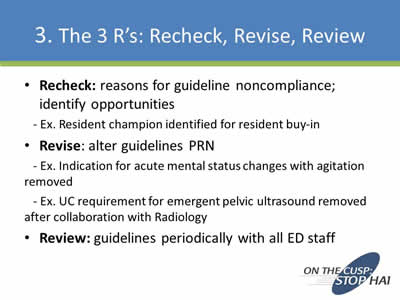
3. The 3 R’s: Recheck, Revise, Review
- Recheck: reasons for guideline noncompliance; identify opportunities:
- Ex. Resident champion identified for resident buy-in
- Revise: alter guidelines PRN:
- Ex. Indication for acute mental status changes with agitation removed
- Ex. UC requirement for emergent pelvic ultrasound removed after collaboration with Radiology
- Review: guidelines periodically with all ED staff
Slide 7
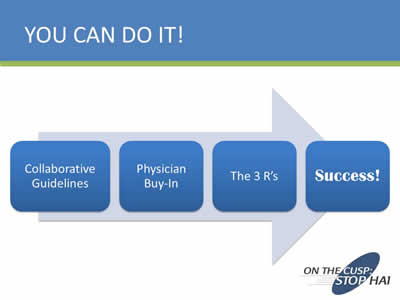
You Can Do It!
Large arrow with the following text boxes imposed over it: Collaborative Guidelines leading to Physician Buy-In leading to The 3 R's leading to Success!
Slide 8

Discussion Questions
- Do you already have an ED attending physician champion?
- What is the greatest barrier you anticipate in establishing this project?
- What successful methods have you used in the past to ensure physician buy-in of clinical processes?
Slide 9

Thank you!
Questions?
Slide 10
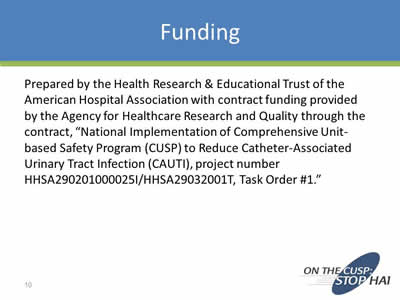
Funding
Prepared by the Health Research & Educational Trust of the American Hospital Association with contract funding provided by the Agency for Healthcare Research and Quality through the contract, “National Implementation of Comprehensive Unit-based Safety Program (CUSP) to Reduce Catheter-Associated Urinary Tract Infection (CAUTI), project number HHSA290201000025I/HHSA29032001T, Task Order #1.”
Return to CAUTI Toolkit Information for Specialty Audiences



